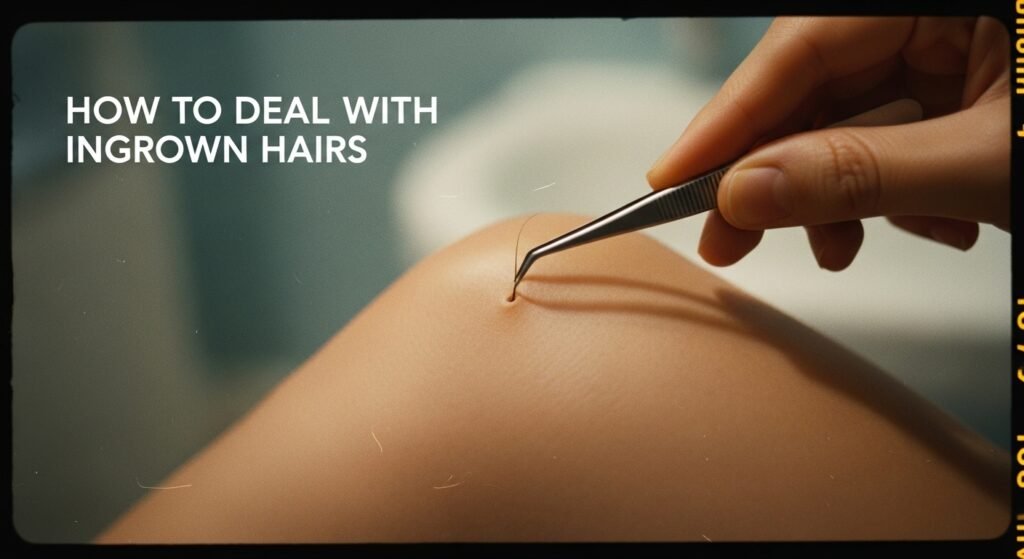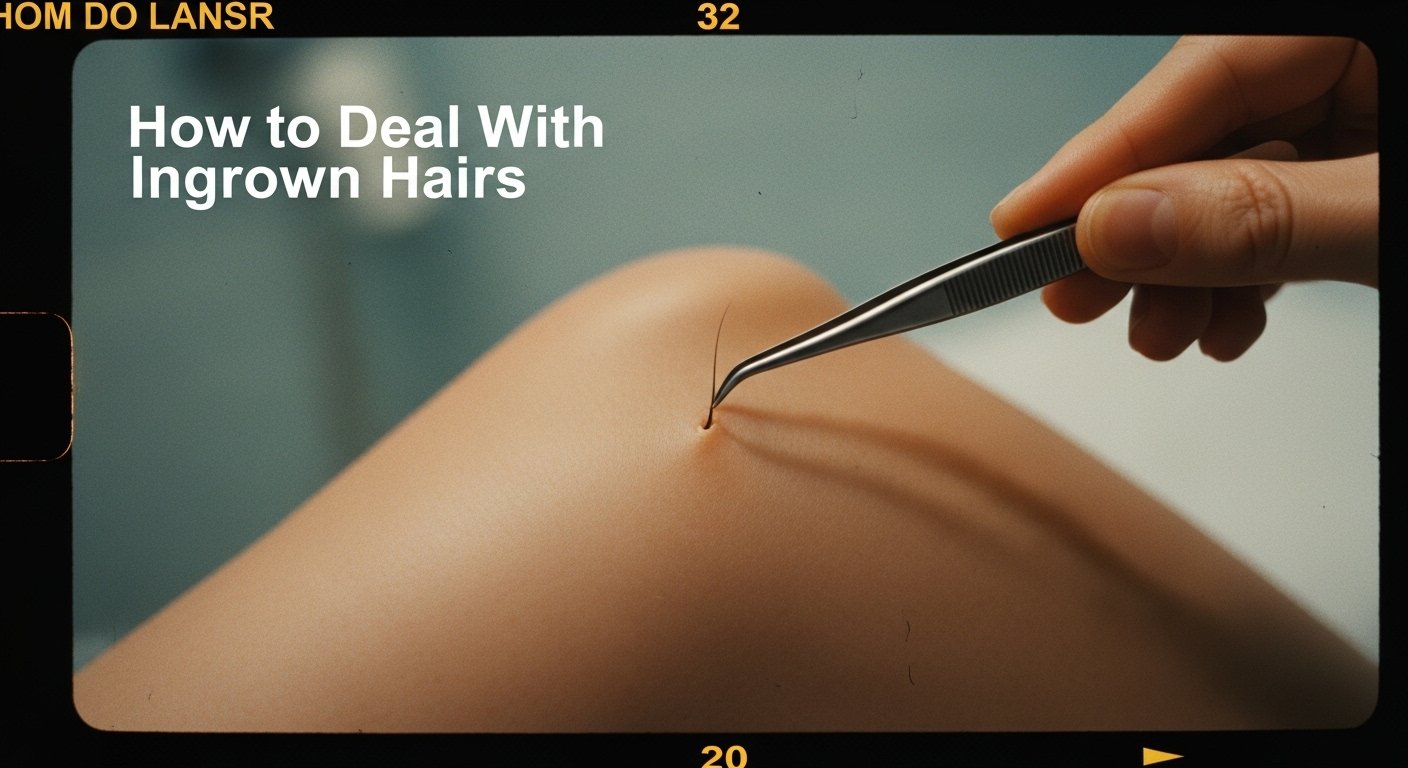How to Deal With Ingrown Hairs
What Are Ingrown Hairs?

Ingrown hairs happen when a hair grows sideways or curls back into the skin instead of outward. The result? Small bumps that can feel itchy, tender, or look inflamed. While they’re not dangerous, frequent ingrown hairs can cause irritation, discoloration, and even infection if not treated correctly.
You’ll often notice them after shaving, waxing, or threading — especially in areas with thicker or curlier hair, such as the legs, underarms, bikini line, or face.
Why Ingrown Hairs Happen
Ingrown hairs develop when dead skin cells clog a follicle or when hair breaks unevenly during removal. Factors like friction from clothing, dry skin, or improper shaving techniques can increase the risk.
From a skincare perspective, the main causes include:
- Hair texture: Curly or coarse hair tends to curl back into the skin.
- Improper exfoliation: Dead skin blocks the follicle opening.
- Dull razors or tight shaving: These cut hair too close, encouraging it to grow inward.
- Lack of moisture: Dry skin increases friction and irritation.
Quick Answer: How to Deal With Ingrown Hairs Fast
If you want a quick, evidence-based solution:
- Apply a warm compress for 10–15 minutes to soften skin and open pores.
- Use gentle exfoliation (a mild scrub or exfoliating glove).
- Apply topical products with salicylic acid, glycolic acid, or tea tree oil.
- Avoid shaving, waxing, or threading the area until the irritation heals.
- Keep the skin moisturized with a fragrance-free, hydrating lotion.
This simple routine helps most mild cases clear up naturally within a few days.
At-Home Remedies for Ingrown Hairs
Treating ingrown hairs at home is safe for most people, as long as you’re gentle. Here’s what works best:
1. Warm Compress Therapy
Soak a soft washcloth in warm water and press it against the affected area for 10–15 minutes. Repeat a few times daily. The warmth helps soften the skin and loosen the trapped hair.
2. Gentle Manual Extraction (Only if Visible)
If a hair loop is visible above the skin, you can lift it out gently using sterile tweezers or a disinfected needle. Never dig under the skin — this can lead to infection or scarring.
3. Use Soothing Topical Agents
Over-the-counter gels with salicylic acid, glycolic acid, or lactic acid can exfoliate dead cells and reduce inflammation. Natural alternatives like tea tree oil and witch hazel have antibacterial properties that calm redness.
4. Exfoliating Masks and Home Treatments
A mild sugar scrub mixed with aloe vera gel or honey offers natural exfoliation while keeping the skin hydrated. Avoid harsh scrubs that cause micro-tears.
Gentle Exfoliation Techniques That Work
Exfoliation is key to preventing ingrown hairs and improving skin texture.
Here’s how to do it safely:
- Mechanical exfoliation: Use a soft brush, washcloth, or exfoliating glove in small circular motions.
- Chemical exfoliation: Apply serums or pads containing AHA (alpha-hydroxy acids) or BHA (beta-hydroxy acids).
- Frequency: Exfoliate 2–3 times per week depending on skin sensitivity.
Consistent exfoliation removes dead cells, unclogs pores, and allows new hair to grow correctly. It’s an essential part of a holistic skin-care or esthetics & spa services routine.
Topical Treatments and Natural Solutions
There are a range of options for treating inflammation, redness, and irritation caused by ingrown hairs.
- Tea Tree Oil: Reduces bacteria and soothes irritation.
- Aloe Vera: Hydrates and heals damaged skin barriers.
- Salicylic Acid: Exfoliates and helps clear clogged follicles.
- Glycolic Acid: Improves cell turnover and smooths texture.
- Moisturizers: Fragrance-free creams maintain hydration and support healing.
When choosing skincare products, look for ingredients designed for sensitive skin, and avoid heavy oils that may clog pores.
Long-Term Prevention Strategies
Prevention is the best cure. These steps will reduce recurrence and improve overall skin health:
Change Your Shaving Routine
- Shave in the direction of hair growth.
- Use a single-blade razor or electric trimmer.
- Always apply a quality shave gel or cream to reduce friction.
- Replace razors frequently to avoid dull blades.
Alternate Hair Removal Methods
- Waxing or threading can reduce shaving frequency, but both can still trigger ingrown hairs if done incorrectly.
- Consider body laser hair removal for a longer-term solution — it weakens follicles, reducing regrowth and minimizing risk.
Hydration & Skin Conditioning
- Use hydrating lotions after every hair removal session.
- Visit professional spa and skincare clinics occasionally for exfoliation or rejuvenating facials.
- Include hand and foot spa treatments for overall circulation and relaxation.
Lifestyle and Skin-Care Habits That Help
Your daily habits play a big role in preventing recurring ingrown hairs:
- Wear loose, breathable clothing to reduce friction.
- Avoid touching or scratching irritated spots.
- Keep your shaving tools clean and sanitized.
- Stay hydrated and maintain balanced nutrition for skin repair.
- Schedule periodic body and face spa sessions for deep cleansing.
Building these habits creates long-term improvements in skin resilience and barrier protection — essential elements of any professional esthetics or spa care plan.
When to See a Professional or Dermatologist
While most ingrown hairs are harmless, some require medical attention. Seek help if:
- The bump becomes painful, red, or swollen.
- You notice pus, heat, or spreading discoloration.
- You experience frequent or clustered outbreaks.
- The bump forms a cyst or leaves dark scars.
A dermatologist can prescribe topical antibiotics, retinoids, or suggest advanced options like laser or light therapy. Early consultation prevents scarring and ensures proper treatment.
FAQs — Common Questions About Ingrown Hairs
No. Avoid squeezing or digging. It increases infection risk and may lead to scarring.
Most mild cases clear up within a few days to a week when treated gently and kept clean.
Yes. They’re gentle enough for sensitive areas and prevent trapped hairs when used 2–3 times weekly.
Consistent exfoliation, proper shaving technique, and if needed, laser hair removal.
Use an electric trimmer instead of a close razor. Apply a post-shave toner with salicylic acid to reduce follicle buildup.
Conclusion: A Calm, Long-Term Approach to Smooth Skin
Dealing with ingrown hairs doesn’t have to be frustrating. With gentle care, proper exfoliation, and a consistent skin-care routine, you can keep your skin healthy and clear.
Combine daily prevention habits with professional care options when needed. Whether you prefer at-home remedies or treatments like laser hair removal, the key is to stay patient, consistent, and kind to your skin.
Smooth, irritation-free skin isn’t about perfection — it’s about smart care, steady habits, and understanding how your body responds to hair growth.

